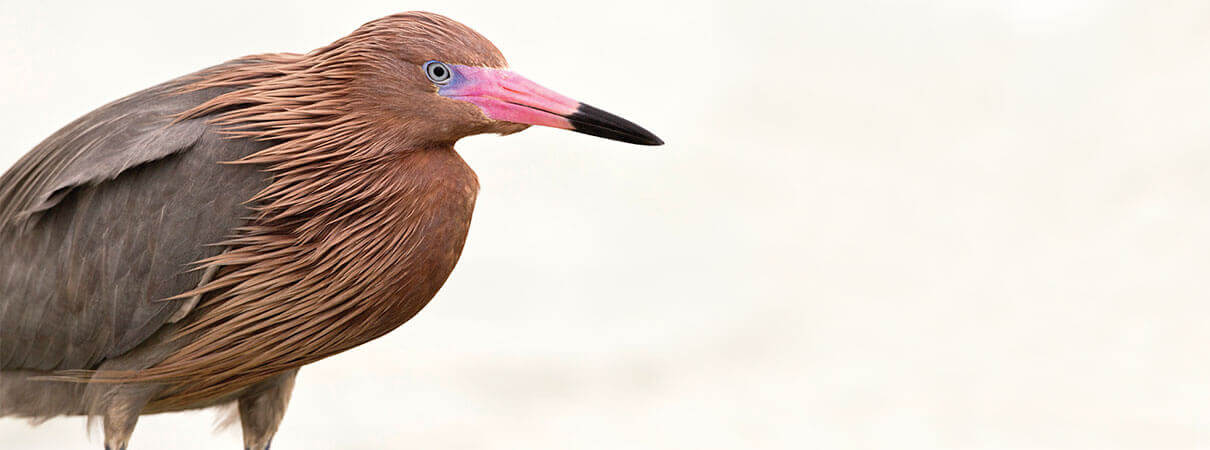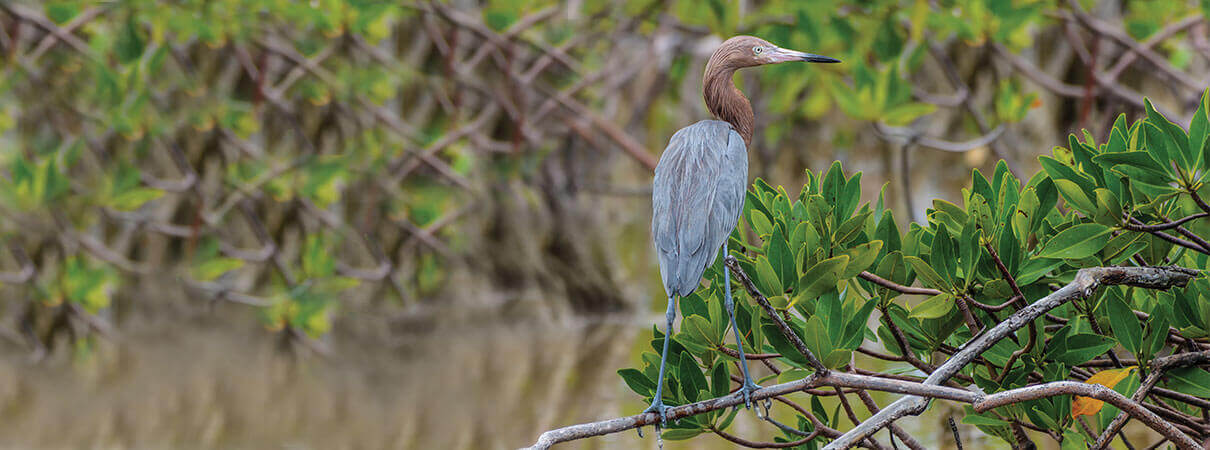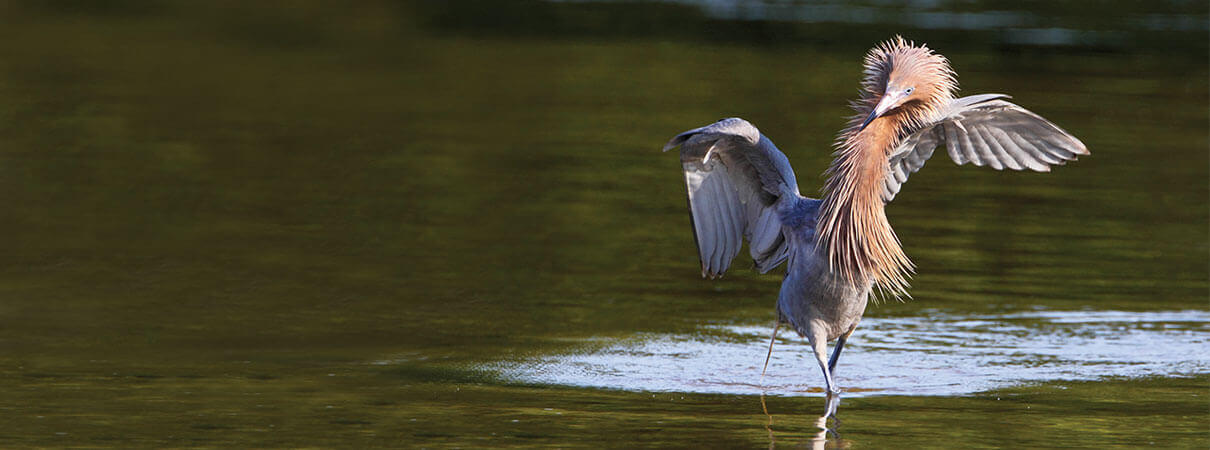Saving the Reddish Egret, a Seashore Sentinel
Reddish Egret conservation efforts may help conserve an entire ecosystem.
It's a warm, humid spring evening on South Padre Island, a thin, 34-mile-long barrier island sheltering the southernmost tip of Texas. The skies are filling with the sharp silhouettes of birds — wings, beaks, tails of all shapes and sizes — as they make their way from their wintering grounds in the southern latitudes to their summer breeding grounds farther north.

Reddish Egret. Photo by Jeff Dyck
As Hooded Warblers, Painted Buntings, Peregrine Falcons, and a suite of other migratory bird species stop at South Padre to rest and refuel, a solitary bird wades through the shallow water. It's tall and slender, with the distinctive shape of an egret, but with a dark belly and a rusty-colored neck. Even more notable is how it moves.
Zig-zagging back and forth on long black legs, running in crazy circles, the Reddish Egret suddenly tucks in its head and raises smooth charcoal wings over itself like an umbrella. With a sudden, precisely timed jab at a passing fish, the bird plunges its sharp pink-and-black beak into the water — and emerges with dinner.
New Focus on a Mysterious Bird
In spite of the Reddish Egret's many notable characteristics, their lives haven't been well studied or understood by scientists. Where do they go when they migrate? How far? Where are they most concentrated, if at all?
What scientists do know about the rarest North American egret species is that its population is declining — an estimated 4,250 breeding pairs exist today, down from at least twice that number in the 1930s — and that the saline coastal habitat it relies on for survival is at major risk of destruction by human activities
Reddish Egret conservation is essential. An international coalition of local and federal agencies, nongovernmental organizations, and universities spread across the bird's geographic range is turning new scientific attention to this striking species: from Laguna Madre further south into Mexico and Central America, throughout the Caribbean, and all along the Gulf of Mexico to Florida. These partners, known collectively as the Reddish Egret Working Group, are collaborating to promote Reddish Egret conservation, unlock the bird's secrets, and ensure its survival.
The Goal: 7,500 Breeding Pairs
Scientists aim to pinpoint important foraging, stopover, and breeding sites, and they are also trying to refine their head counts of Reddish Egrets at these locations. Better population estimates can help them track progress once Reddish Egret conservation measures are put into place. Their blueprint is the Reddish Egret Conservation Action Plan, developed in 2014, to increase the world's Reddish Egret population to 7,500 breeding pairs in about five years.
To meet this goal, the group will work on several fronts. It will manage the factors that directly affect Reddish Egret populations; ensure long-term stewardship and management of priority breeding and foraging areas; implement long-term monitoring of egret populations; and identify ways to better protect areas that are important to Reddish Egrets.
For a bird whose basic biology is still surprisingly poorly known, this sort of expansive, long-term vision for Reddish Egret conservation is vital.
“If you have healthy habitat for a waterbird like the Reddish Egret, you will have healthy habitat for other aquatic species,” says Jesús Franco, ABC's Assistant Coordinator of the Rio Grande Joint Venture, one of the partners involved in the international working group. “It's a species we shouldn't lose, and we have to work together to make sure that doesn't happen.”

Reddish Egret in mangrove. Photo by FotoRequest/Shutterstock
Survivor of Feather Collectors, DDT
Hunted during the 19th century for their handsome feathers, Reddish Egrets have witnessed the edge of existence. The passage of the Migratory Bird Treaty Act in 1918 made it illegal for hunters to shoot the birds, but by the time the Environmental Protection Agency banned DDT in 1972, the entire U.S. Reddish Egret population had nearly vanished.
Legal protections have allowed the species to rebound a bit in recent decades. But the bird's population numbers are still below historic levels, Franco says. And it now appears even this modest recovery is slowing down, and the species is once again in decline.
However, it's no longer poisons and hunting to blame. Humans are again the culprits, but it's new, modern stressors that are at the root of the problem.
“On both their breeding and feeding grounds, the Reddish Egret occupies a fringe of coastal habitat, and there is a lot of human activity in these areas,” Franco says. One of the most serious factors reducing Reddish Egret survival is habitat loss caused by poorly planned tourism and residential development. Coastal engineering projects — such as energy development and dredging — and shrimp aquaculture are also playing a role.
Sea level rise from climate change is another serious threat, Franco says. It is difficult to predict and perhaps even more difficult to control, resulting in significant flooding and loss of Reddish Egret habitat in some areas. Invasive plants and non-native predators also threaten the species' survival.
All of these factors make life difficult for a bird that needs a very specific kind of habitat to thrive.
Specialist of Shallow, Saline Coastlines
“The species is a coastal specialist,” explains Clay Green, professor of biology at Texas State University in San Marcos, and a founding member of the working group. While Reddish Egrets can nest in a variety of settings — including bare rock, cacti, and mangrove — they forage only in shallow, sparsely vegetated saline coastal habitats.
Their dependence on this specific type of habitat likely influences their distinctive hunting behavior, too. Reddish Egrets are well known in the birding world for their elaborate prey-stalking behavior — what Franco calls the Reddish Egret “crazy dance” — hopping, raising their wings over their heads, and peering at the water as they forage for small fish such as the sheepshead minnow and sometimes for tiny crustaceans, like shrimp. This shadow-casting strategy reduces glare and helps the egret more accurately sight and spear its prey.

Reddish Egret on the prowl. Photo by Wilfred Marissen/Shutterstock
The Reddish Egret may suffer from the consequences of being a habitat specialist, says Kelli Stone, Migratory Bird Biologist with the U.S. Fish and Wildlife Service's Southwest Region. But if the appropriate conditions exist, says Stone, who leads the working group, they appear to weather natural stressors such as hurricanes and decreases in prey abundance quite well. Research by Ken Meyer and scientists at Florida's Avian Research and Conservation Institute during Hurricane Irma in 2017, for instance, found that five GPS-tagged egrets survived the storm by roosting in mangrove forests.
But that resilience applies only if Reddish Egrets have an “appropriate amount and quality of habitat” in which to live, Stone says. “When those habitats are drastically altered, limited, or gone, this species — like other wildlife species — is much more vulnerable.”
Unraveling the Mysteries
Back in Laguna Madre in Tamaulipas, Mexico, just across the water from South Padre Island, Salvador Narváez, a biologist and site leader with ABC partner Pronatura Noreste, says the organization is working with scientists in the U.S. to survey and track Reddish Egrets outfitted with GPS transmitters.
These small, solar-powered devices enable researchers to follow the birds' movements throughout the year. Scientists strap lightweight GPS transmitters onto the egrets like tiny high-tech backpacks. So far, the researchers have outfitted more than three dozen egrets with the devices, on Florida's Sanibel Island and along Laguna Madre. The transmitters feed location data back to researchers in real time.

The five critical Reddish Egret habitat regions identified in Mexico.
Narváez says the research will identify key sites for the conservation of Reddish Egrets and provide greater certainty about the birds' priority habitats for wintering, reproduction, and foraging. The monitoring has already helped Pronatura identify five important Reddish Egret habitat regions in Mexico so far. Each has its own threats that will require conservationists to respond with specific strategies. (Pronatura recently received additional funds from the U.S. Fish and Wildlife Service through the Neotropical Migratory Bird Conservation Act to continue work on this species in Mexico.)
The ongoing research also aims to explore the birds' migratory patterns. Along with the GPS transmitter work, visual surveys and color banding in the U.S., Central America, and the Caribbean have revealed that not all Reddish Egrets migrate. But those who do have a fairly large range — from Louisiana to Guatemala, for example.
Efforts to understand where these birds travel are just the latest results of the multinational research. About a decade ago, the working group completed a genetic study that revealed differences in the DNA of individuals across the extremes of the birds' range. This research helped confirm the movements — or lack of movements — of certain populations of Reddish Egrets, says Texas State University's Clay Green.
But he stresses that scientists need more data to get a clearer picture, particularly in the Caribbean, where less research has been done. The Caribbean islands might be an important key to Reddish Egret conservation.
“The idea is that Cuba may be a bridge or stepping stone between eastern populations in Florida and the Bahamas and central populations in Texas and Mexico,” says Green. Only research can say for sure.
Reddish Egret Conservation
Why have scientists become so keen to work on Reddish Egret conservation in the past decade? Andrew Rothman, ABC's Migratory Bird Program Director, says the plight of the Reddish Egret offers conservationists an opportunity to preserve the shallow coastal ecosystems that are so vital to the bird's survival. “With its strict habitat requirements, the bird is what scientists call an indicator species, signaling the health or frailty of a very specific kind of coastal habitat,” Rothman says.
Consider the mangrove. In an attempt to shore up Reddish Egret habitat in Laguna Madre, ABC's Rio Grande Joint Venture's many partners are working together — and with Pronatura — to restore valuable mangrove forests. Mangroves grow in flooded coastal swamps, protect coastlines from flood damage and erosion, and shelter fish and crabs.
But along parts of Laguna Madre and elsewhere in Reddish Egret habitats, mangroves have been destroyed to make way for manmade infrastructure such as coastal shrimp farms. More mangroves will mean more habitat, improved Reddish Egret conservation, and greater protection for humans from hurricanes, storm surges, and flooding.
Although birders thrill to the sight of this majestic and rare species, Reddish Egrets represent so much more than visual splendor. The Reddish Egret is a survivor, a specialist, and a living barometer of humanity's impacts on shallow coastal ecosystems. That's why Franco, Rothman, and their counterparts in the U.S., Mexico, Central America, and the Caribbean are devoting an immense amount of time and effort to Reddish Egret conservation.
Kelli Stone acknowledges the coalition has its work cut out, but she's hopeful. By working collaboratively, scientists and habitat managers may be able to minimize the impact of these threats to levels that will allow the Reddish Egret population to persist — and even increase.
“If we can save it,” she says, “we will also be saving a whole ecosystem.”
Learn more about the Reddish Egret Working Group.


















































